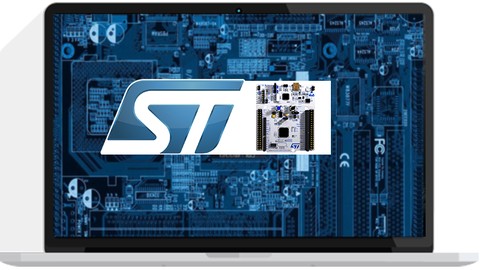
Embedded Systems Bare-Metal Programming Ground Up™ (STM32)
Embedded Systems Bare-Metal Programming Ground Up™ (STM32), available at $109.99, has an average rating of 4.56, with 136 lectures, based on 2570 reviews, and has 15461 subscribers.
You will learn about Write firmware using only bare-metal embedded-c Understand the Cortex-M Architecture Write Analog-to-Digital Converter (ADC) drivers using bare-metal embedded-c Write PWM drivers using bare-metal embedded-c Write UART drivers using bare-metal embedded-c Write TIMER drivers using bare-metal embedded-c Write Interrupt drivers using bare-metal embedded-c Write SPI drivers using bare-metal embedded-c Write I2C drivers using bare-metal embedded-c Master the ARM-Cortex CMSIS standard Write DMA drivers using bare-metal embedded-c Build every single line of code from scratch by writing to the microcontroller’s memory space directly. Use No third party libraries or header files Understand and write every single line of code yourself- no Copy/Paste Use the debugger effectively to analyze and resolve any bugs Develop proficiency in your embedded development skills and confidently take the next steps Define addresses for the different peripherals Analyze the chip documentation Create registers from the addresses This course is ideal for individuals who are If you are an absolute beginner to embedded systems, then take this course. or If you are an experienced embedded developer and want to learn how to professionally develop embedded applications for ARM processors, then take this course. It is particularly useful for If you are an absolute beginner to embedded systems, then take this course. or If you are an experienced embedded developer and want to learn how to professionally develop embedded applications for ARM processors, then take this course.
Enroll now: Embedded Systems Bare-Metal Programming Ground Up™ (STM32)
Summary
Title: Embedded Systems Bare-Metal Programming Ground Up™ (STM32)
Price: $109.99
Average Rating: 4.56
Number of Lectures: 136
Number of Published Lectures: 136
Number of Curriculum Items: 136
Number of Published Curriculum Objects: 136
Original Price: $109.99
Quality Status: approved
Status: Live
What You Will Learn
- Write firmware using only bare-metal embedded-c
- Understand the Cortex-M Architecture
- Write Analog-to-Digital Converter (ADC) drivers using bare-metal embedded-c
- Write PWM drivers using bare-metal embedded-c
- Write UART drivers using bare-metal embedded-c
- Write TIMER drivers using bare-metal embedded-c
- Write Interrupt drivers using bare-metal embedded-c
- Write SPI drivers using bare-metal embedded-c
- Write I2C drivers using bare-metal embedded-c
- Master the ARM-Cortex CMSIS standard
- Write DMA drivers using bare-metal embedded-c
- Build every single line of code from scratch by writing to the microcontroller’s memory space directly.
- Use No third party libraries or header files
- Understand and write every single line of code yourself- no Copy/Paste
- Use the debugger effectively to analyze and resolve any bugs
- Develop proficiency in your embedded development skills and confidently take the next steps
- Define addresses for the different peripherals
- Analyze the chip documentation
- Create registers from the addresses
Who Should Attend
- If you are an absolute beginner to embedded systems, then take this course.
- If you are an experienced embedded developer and want to learn how to professionally develop embedded applications for ARM processors, then take this course.
Target Audiences
- If you are an absolute beginner to embedded systems, then take this course.
- If you are an experienced embedded developer and want to learn how to professionally develop embedded applications for ARM processors, then take this course.
Are you tired of Copying and Pasting code you don’t understand?
With a programming based approach, this course is designed to give you a solid foundation in bare-metal firmware development for ARM-based microcontrollers . The goal of this course is to teach you how to navigate themicrocontroller reference manual and datasheet to extract the right information to professionally build peripheral drivers and firmware. To achieve this goal, no libraries are used in this course, purely bare-metal embedded-c and register manipulations.
Still keeping it simple, this course comes in different ARM Cortex-M development boards so that students can put the techniques to practice using an ARM Cortex-M development board of their choice. This version of the course uses the STMicroelectronics STM32F4-NUCLEO which has an ARM Cortex-M4 microcontoller.
So with that understood, let me tell you…
Exactly What You’re Getting
This is dramatically different from any course you have ever taken because it’s more of a professional hands-on “field guide” to stm32 bare metal firmware development.
The reason why is because there’s no fluff or filler. It immediately gets down to the actual subject, showing you exactly what to do, how to do it, and why.
Plus, it’s easy.
And you’ll immediately “get” the entire mythology I personally use to build firmware for consumer devices in my professional life.
It’s About MORE Than Just Getting the Code to Work
See, this course will change your professional life forever. Here is what one student had to say about the course :
“I would suggest this course for all the beginners. The concepts have been covered in the right sequence.And also the best part of this lecture series is getting to know how to explore the reference manual and datasheets.”
Here is what another student had to say :
“Extremly helpful to get to understand the uC programming deeper! For me it is much easier from now to develop code because I undertstand the base behind, so I’m more confident and more experienced to develop and debug the code. Really, this course is very useful to link the hardware knowledge with the coding skills. This fills the gap between them. Thanks for it! 🙂“
A third student :
“I am a professional semiconductor chipset application engineer with 30 years in global embedded product design in system applications. I can say this teacher is very straight forward by sharing his many years knowledge to the students with his true heart. Yes. I love his teaching pace and style!“
Taken by 8000+ Students with 1000+ Reviews
If at least one of the following applies to you then keep reading if not then simply skip this course:
” Escape From “
-
Copying/Pasting code you don’t understand
-
Using third party libraries and header files like HAL, LL and StdPeriph
-
Experiencing bugs you don’t understand
-
Being afraid of technical documentations like the reference manual and datasheet of the chip
-
Imposter syndrome
” Arrive At “
-
Building every single line of code from scratch by writing to the microcontroller’s memory space directly.
-
Using No third party libraries or header files
-
Understanding and writing every single line of code yourself- no Copy/Paste
-
Using the debugger effectively to analyze and resolve any bugs
-
Developing proficiency in your embedded development skills and confidently take the next steps
So like I said, there’s more than just getting each piece of code to work.
Here’s an overview of what you’re getting…
-
Analyzing the chip documentations:
Before developing the firmware for any chip you have to learn how to read the documentation provided by the chip manufacturer.
-
Defining Peripheral address
All components on the microcontroller have an address range. To write to a component or read from a component you need to locate its address range in the documentation and properly define the addresses in your code.
-
Creating registers from the address:
The addresses in the address range of a component represent the registers of that component. To access these registers you have effectively typecast the addresses.
-
Understanding CMSIS:
Cortex-Microcontroller Interface Standard (CMSIS)CMSIS is a standard developed by Arm for all Cortex-Microcontrollers. This is the standard used in professional firmware development
But it gets better because you’re also getting…
Deep Lessons on Developing Peripheral Drivers
You will learn how to develop bare-metal drivers for the following peripherals :
-
Analog-to-Digital Converter (ADC)
-
Serial Peripheral Interface (SPI)
-
Inter-Integrated Circuit (I2C)
-
Direct Memory Access (DMA)
-
Nested Vector Interrupt Controller (NVIC)
-
General Purpose Timers (TIM)
-
System Tick Timer (SysTick)
-
General Purpose Input/Output (GPIO)
Specially Designed For People Who Hate Copy/Paste
Listen. If you don’t like “Copy/Paste” you’re not alone. I can’t stand it either. I’d literally rather have a piece of code that I wrote from scratch that doesn’t work than someone else’s working code I copied and pasted.
And that’s why I’ve spent months designing and recording this course in which I show you how to locate every single register used and the meaning of every hexadecimal value written into the register.
Also it comes with a money back guarantee so you have nothing to loose.
Course Curriculum
Chapter 1: Getting Started – Constructing Peripheral Registers from Memory Addresses
Lecture 1: Downloading our Integrated Development Environment (IDE)
Lecture 2: Installing our Integrated Development Environment (IDE)
Lecture 3: Getting the right Documentation for Bare-Metal Development
Lecture 4: Coding : Locating the Ports and Pins of Components on the Nucleo board
Lecture 5: Coding : Defining Addresses of Modules using information from the Documentation
Lecture 6: Coding : Creating required Registers using Information from Documentation
Lecture 7: Coding : Configuring Pins using the Registers we Created
Lecture 8: Coding : Creating Registers from Structure Members
Lecture 9: Notice
Chapter 2: General Purpose Input/Output(GPIO)
Lecture 1: Overview of ARM Cortex-M General Purpose Input/Output Module
Lecture 2: Coding : Developing the GPIO Output Driver
Lecture 3: Coding : Controlling GPIO Outputs using the Bit Set/Reset Register (BSRR)
Lecture 4: Coding : Developing the GPIO Input Driver
Chapter 3: Universal Asynchronous Receiver-Transmitter(UART)
Lecture 1: Overview of the UART Protocol
Lecture 2: Coding : Developing the UART Transmitter Driver
Lecture 3: Coding : Testing the UART Transmitter Driver
Lecture 4: Coding : Retargeting printf
Lecture 5: Coding : Making the Driver more Modular
Lecture 6: Coding : Developing the UART Receiver Driver
Lecture 7: Coding : Testing the UART Receiver Driver
Chapter 4: Analog to Digital Conversion (ADC)
Lecture 1: Introduction to Analog to Digital Conversion
Lecture 2: Understanding ADC Independents Modes
Lecture 3: Coding : Developing the ADC Single Conversion Driver
Lecture 4: Coding : Developing the ADC Continuous Conversion Driver
Chapter 5: The System Tick (SysTick) Timer
Lecture 1: Overview of the System Tick Timer
Lecture 2: Coding : Developing the System Tick Timer Driver
Chapter 6: General Purpose Timers
Lecture 1: Overview of General Purpose Timers
Lecture 2: Commonly used Timer registers
Lecture 3: Coding : Developing the General Purpose Timer Driver
Lecture 4: Coding : Developing the Timer Output Compare Driver
Lecture 5: Coding : Developing the Timer Input Capture Driver
Chapter 7: Interrupt Programming
Lecture 1: Introduction to Interrupts
Lecture 2: Coding : Developing the GPIO Interrupt Driver
Lecture 3: Coding : Testing the GPIO Interrupt Driver
Lecture 4: Coding : Developing the UART Receiver Interrupt Driver
Lecture 5: Coding : Developing the ADC Interrupt Driver
Lecture 6: Coding : Developing the Systick Interrupt Driver
Lecture 7: Coding : Developing the Timer Interrupt Driver
Chapter 8: Direct Memory Access (DMA) Driver Development
Lecture 1: Overview of the Direct Memory Access (DMA) Module
Lecture 2: Coding : Developing the UART Transmitter DMA Driver Pt.1
Lecture 3: Coding : Developing the UART Transmitter DMA Driver Pt.2
Lecture 4: Coding : Testing the UART Transmitter DMA Driver
Chapter 9: Inter-Integrated Circuit (I2C)
Lecture 1: Introduction to I2C
Lecture 2: Coding : Implementing the I2C Init function
Lecture 3: Coding : Implementing the I2C Byte Read function
Lecture 4: Coding : Implementing the I2C Burst Read function
Lecture 5: Coding : Implementing the I2C Burst Write function
Lecture 6: Coding : Configuring the ADXL345 Accelerometer using the I2C driver
Lecture 7: Coding : Testing the ADXL345 Accelerometer using the I2C driver
Chapter 10: Serial Peripheral Interface (SPI)
Lecture 1: Introduction to Serial Peripheral Interface (SPI)
Lecture 2: Coding : Implementing the SPI GPIO Initialization function
Lecture 3: Coding : Configuring the SPI Parameters
Lecture 4: Coding : Implementing the SPI Transmit
Lecture 5: Coding : Implementing the SPI Receive
Lecture 6: Coding : Configuring the ADXL345 Accelerometer using the SPI Driver
Lecture 7: Coding : Testing our ADXL345 Driver
Chapter 11: Start of Old Version of the Course – Introduction
Lecture 1: Introduction
Chapter 12: Set Up
Lecture 1: Download Keil uVision 5
Lecture 2: Installing Keil uVision 5
Lecture 3: Notice
Lecture 4: Installing Packs
Lecture 5: Changing the Compiler
Chapter 13: General Purpose Input/Output(GPIO)
Lecture 1: Overview of ARM Cortex-M General Purpose Input/Output Module
Lecture 2: Coding : Developing GPIO Driver Using Information from the Datasheet
Lecture 3: Understanding the BSRR Register
Lecture 4: Coding : Controlling GPIO using the BSRR Register
Lecture 5: Coding : Reading GPIO Inputs
Lecture 6: Notice
Chapter 14: Writing Bare-Metal C Code with STM32CubeIDE
Lecture 1: Notice
Lecture 2: Coding : Writing a GPIO Driver from Scratch (PART I)
Lecture 3: Coding : Writing a GPIO Driver from Scratch (PART II)
Chapter 15: Universal Asynchronous Receiver-Transmitter(UART)
Lecture 1: Overview of the UART Protocol
Lecture 2: Commonly used UART registers
Lecture 3: Coding : Developing the UART Driver Using Information from the Datasheet
Lecture 4: Further discussion on UART Alternate Function configuration
Lecture 5: Coding : Receiving Data with the UART
Lecture 6: Coding : Two-way UART Communication
Chapter 16: System Tick and General Purpose Timers
Lecture 1: Overview of the System Tick Timer
Lecture 2: Overview of General Purpose Timers
Lecture 3: Commonly used Timer registers
Lecture 4: Coding : Developing the System Tick Timer Driver
Lecture 5: Further discussion on System Tick Registers
Lecture 6: Coding : Creating a Delay Function using the System Tick Timer
Lecture 7: Coding : Developing the General Purpose Timer (GPTM) Driver
Instructors
-
Israel Gbati
Embedded Firmware Engineer -
BHM Engineering Academy
21st Century Engineering Academy
Rating Distribution
- 1 stars: 28 votes
- 2 stars: 42 votes
- 3 stars: 248 votes
- 4 stars: 903 votes
- 5 stars: 1349 votes
Frequently Asked Questions
How long do I have access to the course materials?
You can view and review the lecture materials indefinitely, like an on-demand channel.
Can I take my courses with me wherever I go?
Definitely! If you have an internet connection, courses on Udemy are available on any device at any time. If you don’t have an internet connection, some instructors also let their students download course lectures. That’s up to the instructor though, so make sure you get on their good side!
You may also like
- Best Video Editing Courses to Learn in February 2025
- Best Music Production Courses to Learn in February 2025
- Best Animation Courses to Learn in February 2025
- Best Digital Illustration Courses to Learn in February 2025
- Best Renewable Energy Courses to Learn in February 2025
- Best Sustainable Living Courses to Learn in February 2025
- Best Ethical AI Courses to Learn in February 2025
- Best Cybersecurity Fundamentals Courses to Learn in February 2025
- Best Smart Home Technology Courses to Learn in February 2025
- Best Holistic Health Courses to Learn in February 2025
- Best Nutrition And Diet Planning Courses to Learn in February 2025
- Best Yoga Instruction Courses to Learn in February 2025
- Best Stress Management Courses to Learn in February 2025
- Best Mindfulness Meditation Courses to Learn in February 2025
- Best Life Coaching Courses to Learn in February 2025
- Best Career Development Courses to Learn in February 2025
- Best Relationship Building Courses to Learn in February 2025
- Best Parenting Skills Courses to Learn in February 2025
- Best Home Improvement Courses to Learn in February 2025
- Best Gardening Courses to Learn in February 2025























